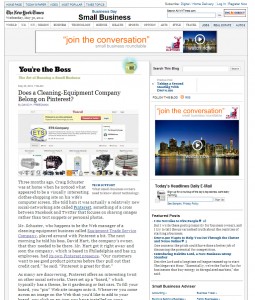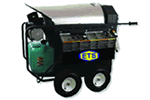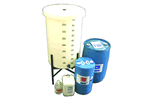From New York Times – Does a Cleaning-Equipment Company Belong on Pinterest?
Three months ago, Craig Schuster was at home when he noticed what appeared to be a visually interesting clothes-shopping site on his wife’s computer screen. She told him it was actually a relatively new social-networking site called Pinterest, something of a cross between Facebook and Twitter that focuses on sharing images rather than text snippets or personal photos.
Mr. Schuster, who happens to be the Web manager of a cleaning-equipment business called Equipment Trade Service Company, played around with Pinterest a bit. The next morning he told his boss, David Hart, the company’s owner, that they needed to be there. Mr. Hart got it right away and soon the company, which is based in Philadelphia and has 23 employees, had its own Pinterest presence. “Our customers want to see good product pictures before they pull out that credit card,” he said. “Pinterest is great for that.”
As many are discovering, Pinterest offers an interesting twist on other social networks. Users set up a “board,” which typically has a theme, be it gardening or fast cars. To fill your board, you “pin” Web site images onto it. Whenever you come across an image on the Web that you’d like to add to your board, you click on an icon you have installed on your browser, and voila, the image appears on your board (you can have more than one). And, as with Twitter, people can “follow” any or all of your boards and get updates whenever you pin something. And of course the service has various means for helping people find new boards they might find interesting, or share those they appreciate.
So far, Pinterest has become one of the fastest growing sites on the Web mostly through the postings of individuals, not businesses. But businesses have been taking notice — especially those with a strong visual component, for example those dealing with arts, crafts, clothes, food or jewelry. It is less obvious why a cleaning-equipment business would be excited about Pinterest. But that didn’t stop Mr. Schuster and Mr. Hart.
Equipment Trade Service sells industrial power-washing machines, parts for those machines, and graffiti-removal detergents, and it sells them mostly to schools, departments of transportation and other institutions. But its sell has become surprisingly visual. When Mr. Schuster came on about eight years ago, he beefed up the Web site, added search optimization, put up videos on YouTube of the equipment and detergents doing their magic, and promoted the videos and site with Facebook and Twitter. Sales climbed rapidly, growing about 20 percent a year, and these days most customers buy online. The company now sells internationally, too. “Those videos really show how well our products work,” Mr. Hart said. Photos help sell the equipment, too, he added. And parts buyers like to see photos to make sure they’re getting the right part for the right machine.
But Mr. Hart and Mr. Schuster also felt the limitations in existing online-marketing channels. Facebook only lets you put up tiny thumbnail pictures with your posts. (You can put bigger pictures in Facebook photo albums, but then you’re limited to very brief captions.) Tweets don’t have photos at all. And neither lends itself to the catalog-like displays and descriptions of products that ETS favors. The company does all of that on its Web site, of course, but Web sites don’t have the social connections that can spread the word and bring in eyeballs. “More and more, people don’t want to type in a Web site name, especially if they’re using a smartphone,” Mr. Schuster said. “They’re looking to see what gets mentioned in a Facebook post or a tweet.”
With its emphasis on fairly big images and its ability to handle long captions, Pinterest fills those needs, Mr. Hart said. The site makes it easy for potential customers who are browsing Pinterest to stumble onto boards of interest through tags. You can put any tags you want on your own boards, of course, but Pinterest also lets others tag them, making it more likely your boards will turn up in a Pinterest search. If an ETS customer — or anyone who happens to admire pictures of cleaning supplies or power cleaners or vanishing graffiti — wants to call attention to a particular photo on an ETS board, he or she can”re-pin” it to his or her own board, or “like” it. And of course new “pins” to a board can be passed around via Facebook or Twitter. “And we just found out Pinterest lets you put up videos from YouTube,” Mr. Hart said.
Of course, that does raise a question: What kind of Pinterest user would want to pin a photo of cleaning equipment or cleaning fluid to his or her own board? Mostly, Mr. Hart said, people who buy cleaning supplies in bulk and are looking to share their finds with other such buyers (think people who belong to industry associations). Mr. Hart concedes that the company still has a lot to figure out when it comes to integrating Pinterest into its marketing strategy. It’s not easy to get Pinterest pages to show up high in a Google search. That means for now most prospective ETS customers will have to learn about it by first coming to the company’s Web site.
The biggest downside to Pinterest for ETS is that so far it has only a tiny fraction of the number of users drawn by Facebook and Twitter. Thus, ETS has in the range of a thousand people who “like” its three Facebook pages and several hundred Twitter followers but only a few dozen Pinterest followers at the moment. “The huge base isn’t there yet,” Mr. Hart said.
Mr. Hart also complained that Pinterest, like Facebook and Twitter, lacks the sort of analytics that Google provides for tracking traffic and figuring out how people get to your Web site, which makes it harder to know what needs to be tweaked to increase traffic. Google analytics can track how many visitors to the company’s Web site came to it through Pinterest — but so far, that number is negligible. All in all, Mr. Hart concedes there has been little concrete payback for the time invested in Pinterest, and there’s no real evidence that the payback will be there down the road. But Mr. Schuster expects the number of visitors to the ETS boards to grow, and given the advantages in displaying the company’s wares and the ability for visitors to share their interest in them, he believes it’s worth a few hours a week.
It would be nice, he added, if customers could just click a “buy” button when they see a photo of a product they like on Pinterest. But for now, at least, the social network is keeping things, well, social.
You can follow David H. Freedman on Twitter, Facebook and on Google Plus.
http://boss.blogs.nytimes.com/2012/05/30/does-a-cleaning-equipment-company-belong-on-pinterest/










